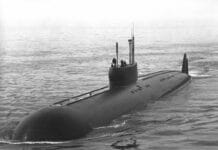Humans have been travelling by sea for thousands of years, so it’s probably not surprising that there have been quite a few weird boat designs. Ernest Bazin’s ship is a great example of that – this ship, launched in 1896, had huge metal wheels. And no, it wasn’t amphibious.
If you were to witness a boat with wheels, you would probably think that it can come ashore. There are such amphibious boats, but usually they are quite small. French engineer Ernest Bazin had a completely different idea – he wanted to create an extremely fast and economical ocean liner with huge wheels.
Ernest Bazin (1826-1898) had an inexhaustible imagination and spent his days inventing stuff. He designed an electric plough, several pieces of mining equipment, a coffee maker, a brick press, an underwater lamp, a loom for hemp and aloe fibres and so many other different things! He was inventing things left and right. His most notable experiments included dirigibles and a wheeled catamaran design.

Bazin, like many other engineers of the time, was looking for a way to give ships more speed. He became interested in ship technology when he was travelling across the Indian Ocean. At the end of the 19th century, ships were the only way to reach other continents. Time is money, time is speed, but at that time fast ocean liners could barely exceed 20 knots (around 37 kph). Bazin saw an opportunity in this area and calculated that a dynamic hull would allow ships to reach a top speed of 47 knots (87 kph). And by dynamic, of course, he meant moving. The entire hull of a ship could be moving to reduce drag.
Basin decided to replace the usual hull of the ship with wheels in a sort of dynamic catamaran configuration. Because a smaller part of a ship would be submerged, there would be less hydrodynamic friction and the ship would travel faster while using less fuel (in this case, coal). According to Bazin’s drawings, a ship with a dynamic hull would have 3 or 4 pairs of rotating wheels. And that’s key – rotating wheels! Unlike a conventional catamaran, Bazin’s hull would be dynamic – those giant wheels would be powered to allow the ship to roll across the water with very little drag.

Bazin spent five years developing this idea and testing small mockups of this design. Eventually, on August 19, 1896, a ship named Ernest-Bazin was launched in the city of Saint-Denis. It had three pairs of wheels and weighed more than 2,5 hundred tons. Each wheel had a diameter of 10 metres, the ship itself was about 40 metres long. Ernest-Bazin was an impressive-looking boat, reminiscent of some kind of a giant child’s toy.
Ernest-Bazin had 6 wheels, but it was just another test boat. Bazin planned that the completed ocean-going ship would have 8 wheels and be even more efficient and faster. The engineer calculated that the Ernest-Bazin could exceed 20 knots, but the completed eight-wheeled vessel with a much more powerful engine would reach a speed of 47 knots (87 km/h). It is true that his contemporaries believed that Bazin’s ship would not exceed a speed of 32 knots (68.5 km/h) in any way, but even that would have been a great achievement.

The wheels of Ernest-Bazin were tapered towards the edges. When sailing, usually about a third of a disc was under water. Those wheels were powered – they were rotating – but only to reduce friction. The ship itself was pushed by a propeller. Ernest Bazin had calculated that a wheeled ship would cross the Atlantic ocean with 4-5 times less coal and would do that much faster than the best steamships of the time.
Ernest-Bazin looked impressive but, as you can probably guess, it was not a success story. In 1897 Ernest-Bazin was preparing to roll across the English Channel. This voyage would have proven that Bazin’s ideas were worthy of attention – if the test was successful, they would have built a larger 8 wheeled ship. However, it quickly became clear that the wheeled ship had one serious drawback.

Bazin’s calculations missed one important detail – water. Weirdly enough, Basin’s wheels could only reduce friction if they didn’t get too wet. Spinning wheels were lifting so much water up that this rolling over sea effect was impossible. In fact, these wheels themselves were slowing down, because of all that clingy water. Coal consumption in this experimental boat was even higher than of similar vessels and its speed was lower. In the ideal world, the rotational speed of those wheels should match the speed of the boat so that it could actually roll along. But it was impossible, because the water is always moving. Plus, on top of that, Bazin’s wheels were heavy and expensive to make, while the catamaran hull itself was not ideal in stormy conditions.
Instead of becoming the beginning of a new direction in ship architecture, the Ernest-Bazin turned out to be an impractical and pretty much useless vessel. It quickly became a pile of scrap metal. Similar ideas were revisited many times, thinking that the wheels could be covered with a hydrophobic coating, but as you can see, the ships kept a more or less traditional hull shape. With many improvements, of course – have you noticed that many larger ships have a bulbous bow?




